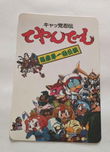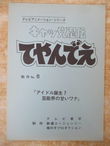Cartoons
11
Posts
0
Followers
Cartoons
11
Posts
0
Followers
In Japan, drama CDs, soundtrack albums, and radio program recordings were major tie-ins for anime and tokusatsu series before CDs completely took over. Fans would record episodes or buy limited-run “drama tapes,” and publishers sometimes included blank cassettes with themed label sheets so you could decorate your tapes yourself — kind of like an early personalization merch.
Labels like these were:
Promotional freebies bundled with magazines, drama tapes, or mail-order sets.
Sometimes store exclusives, given to customers who bought a related OST or tape.
Officially printed by studios like Tatsunoko or production partners, but not always reissued once the CD age began.
📼 Why Japan Loved Them
Home recording culture was huge — kids recorded anime openings, radio dramas, or even their own “mix tapes” of favorite episodes.
Design appeal: Each series had themed label art so fans could match the cassette to their favorite characters.
Collectibility: Some came in full sets (like this Teyandee set) with variant artwork or bonus mini calendars and postcards — they’re now rare because most people used and discarded them.
🐱 In Samurai Pizza Cats’ Case
For Kyattou Ninden Teyandee, these labels likely coincided with the Tatsunoko “Drama CD” and soundtrack releases in the early ’90s.
The bonus calendar card was a common type of “omake” (extra) bundled with tapes or CDs.
This was very much a Japan-specific merchandising phenomenon. Western releases rarely included such paper extras because home-recording tie-ins weren’t a major retail strategy here.
Character: Omitsu / Lucille
Episode: 14 – お願い!コーン守は人気がほしい / Those Transformin' Felines
Medium: Hand-painted production cel on acetate, no background (although you can see my ceiling reflected in the cel).
Layer Code: B-5 End marks it as the final animation layer in that cut.
Studio: Tatsunoko Production (1990–1991 TV run)
Status: Single-layer setup (no visible A/B overlap)
Scene Context: This cel appears right as Omitsu imagines herself gazing lovingly at Nyanki #1, her face softening in a tender daydream before the scene cuts to reality.
The accompanying genga includes original color codes for her palette (PP93, BG20, R80, etc.) — these notations helped colorists match tones frame-to-frame.
The genga and cel are perfectly matched, showing her profile view and shy smile from the start of the fantasy sequence.
Traditional anime relied on hand-painted acetate cels to bring emotional scenes like Omitsu’s to life. For moments of imagination or introspection, directors often used:
• Softer color palettes and simplified linework to distinguish fantasy from reality.
• Background overlays (like the pink hearts seen here) to visually cue emotional shifts.
• Limited animation (fewer cel layers) to emphasize stillness and expression over motion.
Because these dreamlike shots were brief and expressive, the corresponding cels were often discarded or reused—making surviving examples like this one particularly rare and collectible.
Character: Otama / Francine
Episode: 25 – “かわいい?ヤッ太郎女になる / Gender Bender Butterflies! (Ending scene)
Medium: Hand-painted production cel on acetate with randomly chosen painted stock background
Layer Code: 34-84 (marked in upper-right corner)
Studio: Tatsunoko Production (1990–1991 TV run)
Status: Single-layer setup (no visible A/B overlap)
Cel animation is a traditional animation technique that involves hand-drawing and painting individual frames onto transparent celluloid sheets, called cels, and photographing them in a sequence, to create movement. The cels are layered over static backgrounds, with each cel representing a slight progression of movement, and when played back quickly, these frames create the illusion of a moving image. This method, made popular by Walt Disney Studios, was the dominant form of animation until the rise of digital animation in the late 20th century.
How this works:
Pencil Key Frames: Lead animators drew the main poses on paper.
In-Betweens: Assistants added the transitional drawings that created motion.
Inking & Painting: Line art was traced onto clear cellulose acetate sheets (the “cels”) and painted on the reverse side to keep lines crisp.
Layering: Each character or effect element received its own cel layer – labeled A, B, C, etc. – and was stacked over a hand-painted background.
Photography: The composite stack was photographed frame-by-frame, producing the illusion of movement when played in sequence.
Because every cel represented a single frame, they are one-of-a-kind production artifacts—a direct slice of animation history.

Create an account to discover more interesting stories about collectibles, and share your own with other collectors.
Episode Title: アイドル誕生?芸能界の甘いワナ (The birth of an idol? The sweet trap of the entertainment industry)
English episode name: “Singing Samurai Sensai-tion"
Original air date: March 1st, 1990
Synopsis: Pururun and Omitsu become a hit in Edoropolis as the singing group Lovely Mipple (or simply “Mipple”). Little do they know that they are really a front for bad guys attempt of hypnotize the population.
This episode includes a condensed version of Lovely Mipple’s hit song “YASU-けくナイ!”
Rikinoshin is called into battle when the Nyanki need help.
The monster of the week (“Omedetou #3 & Gozaimasu #7” - or “The Umbrella Brothers” to English-speaking audiences) are based on the Japanese juggling duo Somenosuke and Sometarou Ebiichi.
Ever wondered what makes a script different from a story or a novel? Scripts are blueprints for visual storytelling — they tell you what happens, who says what, and what the audience sees or hears.
Scripts are meant to be read fast and visualized easily. You don’t need long paragraphs or heavy detail — it’s about rhythm, action, and character voice.
I don’t plan on adding a lot of scripts to my collection. The only other one I’m actively attempting to hunt down is episode 25.
















